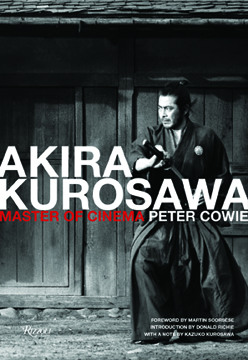(Rizzoli, 304 pages, $75)
By Peter Cowie
 Akira Kurosawa’s centenary is upon us, and Rizzoli is celebrating in grand style with this exquisitely packaged, image-laden homage to the man and his multifaceted work. Rolling out the big guns, it features admiring introductions by Japanese cinema expert Donald Richie, longtime fan Martin Scorsese, and Kurosawa’s daughter Kazuko, followed by a highly perceptive and elegant text by critic Peter Cowie. Cowie breaks down Kurosawa’s career along broad themes rather than purely chronological lines, finding commonalities among and within his groupings, which are far from arbitrary.
Akira Kurosawa’s centenary is upon us, and Rizzoli is celebrating in grand style with this exquisitely packaged, image-laden homage to the man and his multifaceted work. Rolling out the big guns, it features admiring introductions by Japanese cinema expert Donald Richie, longtime fan Martin Scorsese, and Kurosawa’s daughter Kazuko, followed by a highly perceptive and elegant text by critic Peter Cowie. Cowie breaks down Kurosawa’s career along broad themes rather than purely chronological lines, finding commonalities among and within his groupings, which are far from arbitrary.
He assesses the director’s strong literary adaptations, from Dostoevsky’s The Idiot and Gorky’s The Lower Depths, through Throne of Blood and Ran, based on Macbeth and King Lear. Although these films are derived from pessimistic originals, none of Kurosawa’s films is actually pessimistic. If Kurosawa had a theme, writes Cowie, it was “how can men learn to coexist peacefully with one another?”
Cowie discusses Kurosawa’s internationally successful samurai epics (Seven Samurai, Hidden Fortress, Kagemusha) and how they merge their narrative inflections from Hollywood Westerns seamlessly with the director’s Japanese instincts. Indeed, these films have had as much influence on the Western—via John Sturges’ The Magnificent Seven and Sergio Leone’s A Fistful of Dollars—as Ford did on Kurosawa. Less widely known today are Kurosawa’s postwar melodramas, such as No Regrets for Our Youth and Drunken Angel, dealing with the young generation that survived World War II. (Ironically, Regrets was initially censored by postwar US-occupying authorities in Japan after Kurosawa had already been censored by his own government during the war.
Also covered are the thrillers of the 1950s and ’60s: High and Low, The Bad Sleep Well and Stray Dog—the latter from an Ed McBain novel. All of them cast a skeptical eye on the creeping westernization of Kurosawa’s homeland. Additionally, Cowie looks at Kurosawa through the lens of his relationship with actor Toshiro Mifune (Wayne to his Ford, Dietrich to her Sternberg). He perceptively illustrates the director’s formal approach to cinema (his roving camera, all that rain!), and the perceived “westernness” of his work, noting that Kurosawa was widely, perhaps xenophobically, scorned at home from the mid-1960s onwards.
Cowie’s approach offers a short, introductory life of Kurosawa, rather than the sprawling, double bio of the director and Mifune by Stuart Galbraith almost a decade ago. It’s more manageable, more compact, and more lavishly illustrated than Galbraith’s book. Although not as detailed in places, it more than adequately gives us the ABCs of AK.
Review written by John Patterson.